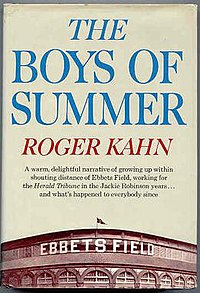
The Los Angeles Dodgers are an American professional baseball team based in Los Angeles. The Dodgers compete in Major League Baseball (MLB) as a member club of the National League (NL) West Division. Established in 1883 in the city of Brooklyn, which in 1898 became a borough of New York City, the team joined the NL in 1890 as the Brooklyn Bridegrooms and assumed several other monikers before finally settling on the name Dodgers in 1932. From the 1940s through the mid-1950s, the Dodgers developed a fierce crosstown rivalry with the New York Yankees as the two clubs faced each other in the World Series seven times, with the Dodgers losing the first five matchups before defeating them to win the franchise's first title in 1955. It was also during this period that the Dodgers made history by breaking the baseball color line in 1947 with the debut of Jackie Robinson, the first African American to play in the Major Leagues since 1884. Another major milestone was reached in 1956 when Don Newcombe became the first player ever to win both the Cy Young Award and the NL MVP in the same season.
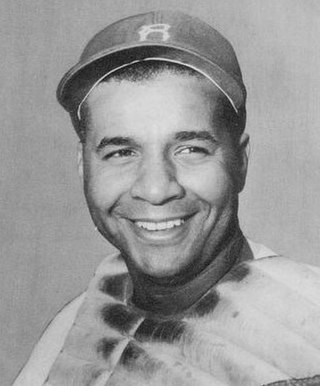
Roy Campanella, nicknamed "Campy", was an American professional baseball player, primarily as a catcher. The Philadelphia native played in the Negro leagues and Mexican League for nine years before entering the minor leagues in 1946. He made his Major League Baseball (MLB) debut in 1948 for the Brooklyn Dodgers, for whom he played until 1957. His playing career ended when he was paralyzed in an automobile accident in January 1958. He is considered one of the greatest catchers in the history of the game.
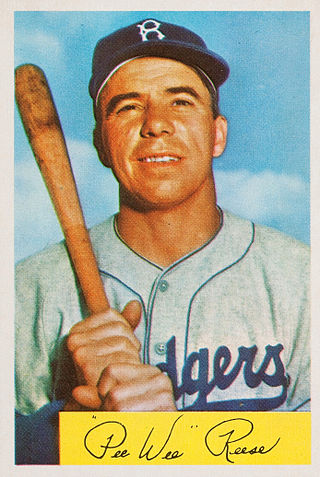
Harold Peter Henry "Pee Wee" Reese was an American professional baseball player. He played in Major League Baseball as a shortstop for the Brooklyn / Los Angeles Dodgers from 1940 to 1958. A ten-time All-Star, Reese contributed to seven National League championships for the Dodgers and was inducted into the Baseball Hall of Fame in 1984. Reese is also famous for his support of his teammate Jackie Robinson, the first black player in the major leagues' modern era, especially in Robinson's difficult first years, most notably when he put his arm around Robinson during a pre-game warmup in front of a heckling crowd.

Gilbert Raymond Hodges was an American first baseman and manager in Major League Baseball (MLB) who played most of his 18-year career for the Brooklyn / Los Angeles Dodgers. An eight-time All-Star, he anchored the infield for the Dodgers through six pennant winners and two World Series titles before leading the New York Mets to their first World Series title in 1969. One of the most beloved and admired players in major league history, Hodges was inducted into the Baseball Hall of Fame in 2022, fifty years after his sudden death.

Edwin Donald "Duke" Snider, nicknamed "the Silver Fox" and "the Duke of Flatbush", was an American professional baseball player. Primarily a center fielder, he spent most of his Major League Baseball (MLB) career playing for the Brooklyn/Los Angeles Dodgers (1947–1962), later playing one season each for the New York Mets (1963) and San Francisco Giants (1964).

Carl Anthony Furillo, nicknamed "the Reading Rifle" and "Skoonj", was an American baseball player who played in Major League Baseball (MLB), spending his entire career with the Brooklyn/Los Angeles Dodgers, primarily as a right fielder.

Walter Francis O'Malley was an American sports executive who owned the Brooklyn / Los Angeles Dodgers team in Major League Baseball from 1950 to 1979. In 1958, as owner of the Dodgers, he brought major league baseball to the West Coast, moving the Dodgers from Brooklyn to Los Angeles despite the Dodgers being the second most profitable team in baseball from 1946 to 1956, and coordinating the move of the New York Giants to San Francisco at a time when there were no teams west of Kansas City, Missouri. In 2008, O'Malley was elected to the National Baseball Hall of Fame for his contributions to and influence on the game of baseball.

James William "Junior" Gilliam was an American second baseman, third baseman, and coach in Negro league and Major League Baseball who spent his entire major league career with the Brooklyn / Los Angeles Dodgers. He was named the 1953 National League Rookie of the Year, and was a key member of ten National League championship teams from 1953 to 1978. As the Dodgers' leadoff hitter for most of the 1950s, he scored over 100 runs in each of his first four seasons and led the National League in triples in 1953 and walks in 1959. Upon retirement, he became one of the first African-American coaches in the major leagues.

Roger Kahn was an American author, best known for his 1972 baseball book The Boys of Summer.
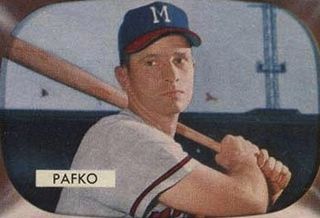
Andrew Pafko was an American professional baseball player. He played in Major League Baseball (MLB) for the Chicago Cubs (1943–51), Brooklyn Dodgers (1951–52), and Milwaukee Braves (1953–59). He batted and threw right-handed and played center field.

Charles Walter Dressen was an American third baseman, manager and coach in professional baseball during a career lasting almost fifty years. He is best known as the manager of the Brooklyn Dodgers from 1951 to 1953, where he won two National League pennants. Indeed, Dressen's "schooling" of a young baseball writer is one of the most colorful themes in Roger Kahn's classic 1972 memoir, The Boys of Summer. He threw and batted right-handed and was listed at 5 feet 5 inches (1.65 m) tall and 145 pounds (66 kg) during his days as an active player.

Carl Daniel Erskine, nicknamed "Oisk", was an American baseball pitcher in Major League Baseball who played his entire career for the Brooklyn/Los Angeles Dodgers from 1948 through 1959. He was a pitching mainstay on Dodger teams which won five National League pennants and the 1955 World Series.

Elwin Charles "Preacher" Roe was an American professional baseball pitcher. He played in Major League Baseball for the St. Louis Cardinals (1938), Pittsburgh Pirates (1944–47), and Brooklyn Dodgers (1948–54). Roe was a five-time All-Star.
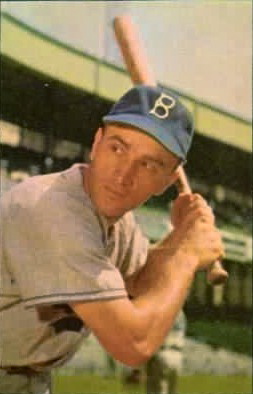
George Thomas Shuba was an American professional baseball utility outfielder and left-handed pinch hitter in Major League Baseball who played seven seasons for the Brooklyn Dodgers. His seven seasons included three World Series as well as a World Series championship in 1955. He was the first National League player to hit a pinch-hit home run in a World Series game.
Jacob Albert Pitler was an American second baseman and longtime coach in Major League Baseball. Born in New York City, and Jewish, he moved with his family to Western Pennsylvania when he was a boy, and he grew up in Beaver Falls and Pittsburgh.
In 1955, the Brooklyn Dodgers finally fulfilled the promise of many previous Dodger teams. Although the club had won several pennants in the past, and had won as many as 105 games in 1953, it had never won a World Series. This team finished 13.5 games ahead in the National League pennant race, leading the league in both runs scored and fewest runs allowed. In the World Series, they finally beat their crosstown rivals, the New York Yankees. It was the Dodgers' first and only World Series championship won while located in Brooklyn.
Brooklyn Dodgers: Ghosts of Flatbush is a 2007 documentary film produced by HBO Sports chronicling the last ten years of the Brooklyn Dodgers' tenure in the borough of churches. The film documents how in 1947 Jackie Robinson broke the baseball racial barrier in previously segregated major league, the struggles to win what seemed an unreachable World Series title in 1955, and the issues and community feelings involved in the team's sudden departure to Los Angeles after the 1957 campaign.
Bums: An Oral History of the Brooklyn Dodgers is a non-fiction baseball book by Peter Golenbock. It was published in 1984 and won the Casey Award for the best baseball book of the year.

The Brooklyn Dodgers were a Major League Baseball team founded in 1883 as the Brooklyn Grays, next year in 1884 becoming a member of the American Association as the Brooklyn Atlantics before joining the National League in 1890. They remained in Brooklyn until 1957, after which the club moved to Los Angeles, California, where it continues its history as the Los Angeles Dodgers. The team moved west at the same time as its longtime rival, the New York Giants, moved to San Francisco in northern California as the San Francisco Giants.

The Last Innocents: The Collision of the Turbulent Sixties and the Los Angeles Dodgers is a book by author Michael Leahy, centered around the Los Angeles Dodgers teams of the 1960s. The book was the winner of the 2016 Casey Award as the best baseball book of the year.
